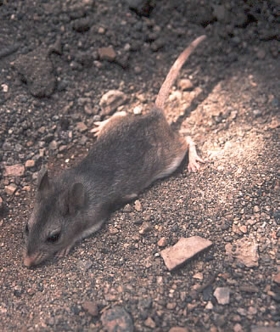

By Jim Knox
The Sonoran Desert of the American Southwest and Northwest Mexico is known as a forbidding daytime landscape of scorching and deadly temperatures. Less familiar to most is that same landscape in nocturnal guise. No less deadly, it conceals a virtually unknown and lethal carnivore.
Hunting the boulder-studded Saguaro stands and scoured arroyos, this predator is unmatched. When night descends, the hunt is on. Stealth is its ally and few species can withstand its relentless attack. Mammals, reptiles, and birds all fall to this marauder. Even the fatally venomous have reason to fear. Tarantulas, snakes, and scorpions all find themselves on its menu. What kind of beast sends these predators scurrying and slithering for cover? Would you believe…a mouse?
Bold and tenacious, the Southern Grasshopper Mouse (Onychomys torridus) has long been revered by Native American tribes for its hunting prowess. Stretching the tape, a mere six inches (the length of a dollar bill) and tipping the scales at just 1.7 ounces (the weight of 17 pennies), this is a mouse by any measure. Yet, this humble façade cloaks a behavioral lion within.
One of just three carnivorous, nocturnal mouse species on the North American continent, the Southern Grasshopper Mouse earns its name for its predilection for grasshoppers and their insect kin. Yet from grasshoppers to scorpions is not much of a taxonomic leap. Here’s where it gets really interesting. Grasshopper Mice actually specialize in taking down venomous prey—such as the potentially fatal Arizona Bark Scorpion—and have specifically evolved to wage war in the chemical / adaptation arms race with their deadly foes. This has yielded a rodent superpower without equal—immunity to venoms.
Over millennia, these modest rodents have developed immunities to various scorpion and snake venoms, equipping them to withstand a direct scorpion sting to the nose that could kill a human! In addition to this ability to reject certain toxins, these remarkable little creatures possess a gene which prevents pain signals from envenomation. This is most telling as it enables the Grasshopper Mouse to fight through blows that would kill a mammal hundreds of times its bulk! This adaptation alone makes them promising subjects in the field of pain therapy compound research. Imagine a day when a patient undergoing pain therapy treatment could owe their relief to the pain blocking abilities of this humble creature.
Employing stealth as they stalk, and lunging for a killing bite, Grasshopper Mice are behaviorally closer to leopards and jaguars than they are to their fellow rodents. They are utterly relentless, repeatedly biting to breach the hardened exoskeleton and disable the central nervous system of prey such as the venomous, Giant Desert Centipede. When vanquishing scorpions, they take a different tact—withstanding the full force of a sting from the scorpion’s telson before biting it off and then eating their formidable prey headfirst!
The mouse caps such battles with its victory howl which carries over the landscape like the howl of a mouse-sized wolf. “As quiet as a church mouse” may describe their retiring, seed-crunching, common brethren. Yet, the Southern Grasshopper Mouse is no common mouse. Aggressive to all comers, Grasshopper Mice do not excavate their own burrows but displace their shy, herbivorous kin—mice, Kangaroo Mice, and voles—when they need new digs. What’s more, they will then kill and eat their evicted cousins, eliminating resource competition and grabbing “fast food” in the process.
Nature has infinite stories she can share. With each one, many lessons to impart. Some of her lessons are clear. Others are more discrete, requiring a closer look at the seemingly mundane. Just when we think we mastered a lesson; a creature comes along which forces us to rethink everything we have learned. “As timid as a mouse.” Such language is embedded in our very cultural definition of these rodents. We know them as skittish, flight-prone animals which dash at the flick of a light switch. This is what we have come to expect. Some mice however, never got the memo. They don’t subscribe to our sweeping language and tidy definitions. They prefer to write their own narrative and thank goodness for them.
In the Southern Grasshopper Mouse, we have a creature which is at-a-glance, retiring, but upon closer inspection, inspiring. When the heart of a lion beats within the body of a mouse, the extraordinary occurs. These tiny mammals earn the respect of all who know them. With the Grasshopper Mouse as your guide, let the world ascribe common expectations while you achieve astounding victories.
Jim Knox serves as the Curator of Education for Connecticut’s Beardsley Zoo and as a Science Adviser for The Bruce Museum. Jim has a passion for working with wild creatures and for sharing that passion with audiences of all ages.




